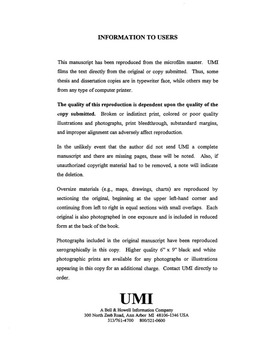| dc.contributor.advisor | Rundstrom, Robert, | en_US |
| dc.contributor.author | Mccormick, Peter John. | en_US |
| dc.date.accessioned | 2013-08-16T12:30:30Z | |
| dc.date.available | 2013-08-16T12:30:30Z | |
| dc.date.issued | 1999 | en_US |
| dc.identifier.uri | https://hdl.handle.net/11244/5797 | |
| dc.description.abstract | New Mexico is one of the most highly imagined places in the United States. It is the consensus of most writers, academics, and artists that three cultures---Anglo, American Indian, and Hispanic--- when combined with the physical landscape produce an almost hallucinogenic quality. New Mexico is, of course, a real place with certain attributes, but it is also a cultural construction. Behind the New Mexico aesthetic, the three-culture land of enchantment, lies a complex story of colonization and cultural exchange. It is my contention that American attitudes held towards New Mexico have been generated by representations grounded in a privileged Anglo-American discourse tied to colonialism. | en_US |
| dc.description.abstract | For over a decade geographers and academics in other humanities and social sciences have generated a breadth of literature on the 'new' American West. The emergence of its urban landscapes, the demise of rural economies and lifestyles, environmental degradation, and rapid economic and demographic change have reconfigured the landscape. Despite the effort to come to terms with this 'new' West, there are few acknowledgments of its under-represented peoples. Contributions from Chicano/a and American Indian communities to the project of redefinition are few. Recent accounts of New Mexico continue to play on the exotic otherness of these communities, ignoring individual differences and shared characteristics among all New Mexicans, reinforcing social distance from mainstream American culture. | en_US |
| dc.description.abstract | This dissertation examines and interprets the imaginative geographies of New Mexico. Its focus is on Rudolfo Anaya, one of the Southwest's most prolific writers and a pioneer in the artistic arm of the Chicano/a movement. His representations of the physical and cultural landscapes of New Mexico, exposed through analysis of his most popular novels, are offered as a counterpoint to the texts that dominate Western regional studies. By employing a sequence of interpretations at different contextual levels and engaging humanistic geography and post-colonial theory, I explore Anaya's self-conscious construction of New Mexico. The study links Anaya's writing and Chicano/a culture to the legacy of conquest in the West. It also offers alternative theoretical and contextual avenues for geographic studies of place. | en_US |
| dc.format.extent | xi, 247 leaves : | en_US |
| dc.subject | Postcolonialism New Mexico. | en_US |
| dc.subject | Literature, American. | en_US |
| dc.subject | Anaya, Rudolfo A. | en_US |
| dc.subject | Geography. | en_US |
| dc.title | Re-imagining New Mexico: Geography, literature, and Rudolfo Anaya. | en_US |
| dc.type | Thesis | en_US |
| dc.thesis.degree | Ph.D. | en_US |
| dc.thesis.degreeDiscipline | Department of Geography and Environmental Sustainability | en_US |
| dc.note | Source: Dissertation Abstracts International, Volume: 60-05, Section: A, page: 1700. | en_US |
| dc.note | Director: Robert Rundstrom. | en_US |
| ou.identifier | (UMI)AAI9929550 | en_US |
| ou.group | College of Atmospheric & Geographic Sciences::Department of Geography and Environmental Sustainability | |
